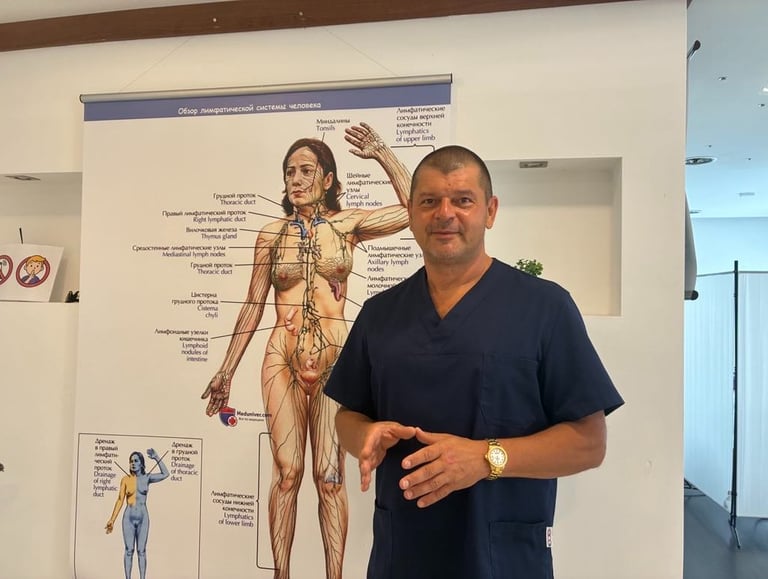Pressotherapy: A Scientific Approach to Prevention and Treatment of Musculoskeletal Disorders
Results of the LoreMeda International Seminar


Introduction
Pressotherapy (intermittent pneumatic compression) is a modern physiotherapeutic method based on apparatus-assisted lymphatic drainage massage using compressed air. Special cuffs alternately compress and relax body parts, stimulating lymphatic and blood circulation. The method affects the lymphatic and venous systems through cyclical tissue compression and possesses significant preventive and therapeutic potential in medicine, rehabilitation, and wellness practices.
Physiological Effects of Pressotherapy
The mechanism of pressotherapy action is based on comprehensive impact on various body systems:
Primary Physiological Effects:
Enhancement of lymphatic drainage and venous outflow — activation of lymph and venous blood movement, improvement of drainage function
Improvement of microcirculation — stimulation of capillary blood flow and metabolic processes in tissues
Reduction of edema and inflammatory markers (IL-6, TNF-α) — decrease of inflammatory processes at molecular level
Activation of parasympathetic nervous system — promotes general relaxation and restorative processes
Systemic Effects:
Systemic improvement of venous and lymphatic outflow — reduces edema, eliminates heaviness in extremities
Relief of fatigue, enhancement of vitality and improvement of sleep
Toxin elimination and tissue "unloading" through increased metabolic processes
Pressotherapy as a Prevention Tool
According to the World Health Organization (WHO) classification, prevention is divided into three levels:
Primary Prevention — disease prevention in healthy individuals
Pressotherapy can prevent the development of:
Lymphostasis and venous insufficiency
Varicose veins in predisposed individuals
Cellulite and metabolic disorders
Psychosomatic disorders and consequences of physical inactivity
Secondary Prevention — stabilization of early disorders
Pressotherapy prevents the development of:
Chronic venous insufficiency (CVI) and chronic edema
Microcirculation disorders
Metabolic syndrome
Vascular dysfunction in perimenopausal women
Tertiary Prevention — reduction of chronic condition complications (with caution)
Pressotherapy can be used:
In chronic lymphostasis (stages I–II)
For prevention of trophic ulcers
For prevention of immobilization edema
Pressotherapy in Musculoskeletal Disorders
Scoliosis
Therapeutic Effects:
Improves muscle nutrition and elasticity by stimulating microcirculation
Relieves spasms and facilitates fluid removal, helping reduce swelling and increase overall comfort
Used in combination with other physiotherapeutic techniques to maintain or restore mobility in patients with movement disorders — including people with limited activity
Osteoporosis
Application Features:
Pressotherapy is not a method for treating bone mass loss, but helps alleviate accompanying manifestations — such as edema and microcirculation disorders
In early stages, it can improve well-being through enhanced blood flow and lymphatic drainage
In severe osteoporosis, medical consultation is mandatory due to increased tissue sensitivity to mechanical impacts
Degenerative and Inflammatory Rheumatological Diseases (osteoarthritis, arthritis)
Clinical Effects:
May reduce pain syndrome through reflex muscle relaxation and improved tissue metabolism
Promotes elimination of venous and lymphatic stasis, which is important in chronic inflammatory processes
Slows progression of degenerative changes, helps preserve joint range of motion
Properly selected pressotherapy courses showed positive dynamics in most patients with osteoarthritis and rheumatoid manifestations
Scientific Evidence of Effectiveness
Clinical effectiveness of pressotherapy is confirmed by multiple studies:
Prevention of thromboembolic complications:
Kim NY et al. (2024). Systematic review and meta-analysis of intermittent pneumatic compression for prevention of deep vein thrombosis in surgical patients
American College of Chest Physicians (ACCP) and ASH recommendations on venous thromboembolism prevention — IPC is recommended when anticoagulants are contraindicated
Clinical Studies:
Dennis M et al. (2013). CLOTS 3 Trial: effectiveness of IPC in immobilized stroke patients (The Lancet)
Lim W et al. (2015). Systematic review of IPC application for venous thromboembolism prevention
Application in Lymphology:
Taradaj J et al. (2015). Effectiveness of intermittent pneumatic compression in lymphatic disorders
Jeyaretnam C et al. (2018). Comparison of different compression methods in lymphedema
Contraindications and Limitations
Absolute Contraindications:
Deep vein thrombosis
Oncological processes
Acute inflammatory diseases
Heart failure grade III
Severe stages of osteoporosis (fracture risk)
Exacerbation of inflammatory diseases
Relative Contraindications:
Pregnancy
Skin diseases in acute stage
Arterial hypertension in decompensation stage
Important: Prior medical consultation and individual parameter selection for the procedure are always required.
Role in Complex Therapy and Rehabilitation
Pressotherapy is often used as part of comprehensive rehabilitation programs: together with drug therapy, therapeutic gymnastics, classical massage, and other physiotherapy procedures. This enhances the therapeutic effect, promotes faster recovery and improves quality of life in patients with musculoskeletal disorders.
Integration into Various Medical Fields:
General medical practice — prevention of venous disorders
Outpatient practice — supportive therapy for chronic conditions
Spa practice — comprehensive health improvement and rehabilitation
Wellness practices — preventive impact and quality of life improvement
Conclusion and LoreMeda Recommendations
Pressotherapy represents an effective method of primary and secondary prevention for a wide spectrum of diseases. The method is applicable in various medical fields and serves as an important complement to physical activity, dietary therapy, and primary treatment.
Key Advantages of the Method:
Safety when properly applied
Wide spectrum of indications
Possibility of use in complex therapy
Pronounced preventive effect
Indications for Application at LoreMeda:
Musculoskeletal disorders (scoliosis, osteoporosis, osteoarthritis, arthritis)
Venous insufficiency and lymphatic disorders
Prevention of thromboembolic complications
Complex rehabilitation and wellness programs
LoreMeda Center ensures individual parameter selection for procedures, use of modern equipment, and professional monitoring of treatment effectiveness, which guarantees maximum safety and efficacy of pressotherapy application.
Material prepared based on the results of the LoreMeda International Seminar with participation of physicians and specialists from different countries.
